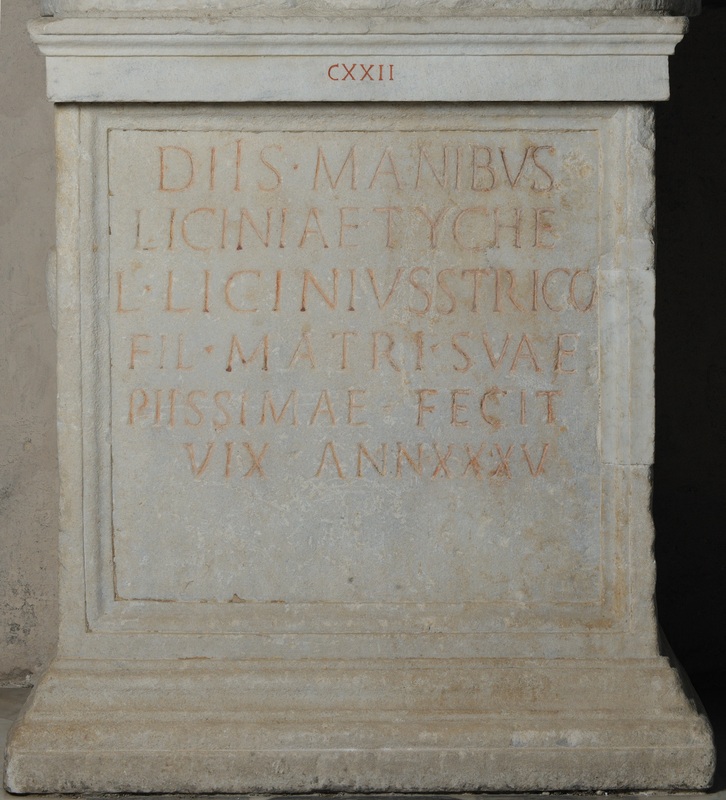Tomb Altar of Licinia Tyche
This four-sided altar is decorated with moulding on the base and the top. The front is inscribed with a funerary dedication from a son to his mother, Licinia Tyche, who died prematurely.
Documented in the sixteenth century in the vineyard of Cardinal Carpi on the Quirinal Hill, it was later mentioned by Montelatici in the Villa Borghese storerooms. Displayed in Room V in 1796, it was mentioned in its current location in the portico in 1832.
The use of the formula Diis Manibus and the double ‘i’ in Diis suggests that the sculpture is datable to the middle of the first century CE.
Object details
Inventory
Location
Date
Seconda metà del I secolo d.C.
Classification
Medium
Dimensions
altezza cm 63; larghezza cm 65; profondità cm 37; altezza lettere cm 4
Provenance
From the collection of Cardinal Carpi (Gruter 1602, p. DCCXXXII, no. 5); Borghese Collection (cited for the first time in the ‘Stanze sotterranee’ (‘underground rooms’) by Montelatici, 1700, p. 308); Inventario Fidecommissario Borghese, 1833, C., p. 41, no. 7. Purchased by the Italian State, 1902.
Inscriptions
Diis Manibus /
Liciniae Tych(a)e /
L(ucius) Licinius Strico /
fil(ius) matri suae /
piissimae fecit. /
Vix(it) ann(is) XXXV
Conservation and Diagnostic
- 17th century - Restoration with pieces of marble
- 1994-1995 - Abacus di N. Naldoni e G. Tautschnig
- 2008 - Consorzio Capitolino di Elisabetta Zatti ed Elisabetta Caracciolo
Commentary
In the sixteenth century, the altar was in the vineyard of Cardinal Carpi on the Quirinal Hill (Gruter 1602, p. DCCXXXII, no. 5); later, in 1700, it was documented by Montelatici in the ‘Stanze sotterranee’ (‘underground rooms’) of the Villa Borghese (Montelatici 1700, p. 308). In 1796, it was in Room V, as a base for the Venus and Cupid standing on a dolphin now in the Louvre (Visconti, Lamberti 1796, II, p. 47). And, finally, in 1832, Nibby mentioned it in its current location in the portico (Nibby, 1832, pp. 15–16).
The sculpture is four sided with an upper cornice composed of a protruding listel, a cyma reversa and a second listel, while the lower one is composed of a wide cyma reversa, an astragal and a smooth band. The epigraphic zone on the front, surrounded by a moulded frame, bears a six-line inscription:
Diis Manibus /
Liciniae Tych(a)e /
L(ucius) Licinius Strico /
fil(ius) matri suae /
piissimae fecit. /
Vix(it) ann(is) XXXV
The sides of the sculpture are decorated with a relief of a small pitcher called a urceus, on the left, and a ritual bowl called a patera umbilicata, on the right. The funerary inscription was dedicated by the son Lucius Licinius Strico to his mother Licinia Tychae, who died at a young age. The invocation to the Diis Manibus with the double ‘i’ in Diis suggests a date for the monument in the middle of the first century CE.
The inscription is included in the Corpus Iscriptionum Latinarum (CIL, VI, 21358).
Giulia Ciccarello
Bibliography
- J. Gruter, Inscriptiones Antiquae Totius orbis Romani in corpus absolutissimum redactae, 1602.
- D. Montelatici, Villa Borghese fuori di Porta Pinciana con l’ornamenti che si osservano nel di lei Palazzo, Roma 1700, p. 308.
- L. Lamberti, E.Q. Visconti, Sculture del palazzo della Villa Borghese detta Pinciana, Roma 1796, II, p. 47.
- A. Nibby, Monumenti scelti della Villa Borghese, Roma 1832, pp. 15-16.
- Indicazione delle opere antiche di scultura esistenti nel primo piano del Palazzo della Villa Borghese, Roma 1854 (1873), I, p. 6, n. 12.
- Corpus Iscriptionum Latinarum, VI, 1886, n. 21358.
- Chr. Hülsen, Römische Antikengärten des XVI. Jahrhunderts, 1917, p. 74, n. 172 z.
- P. Moreno, A. Viacava, I marmi antichi della Galleria Borghese. La collezione archeologica di Camillo e Francesco Borghese, Roma 2003, p. 61, n. 4.
- Scheda di catalogo 12/00147874, P. Moreno 1975; aggiornamento G. Ciccarello 2020.


